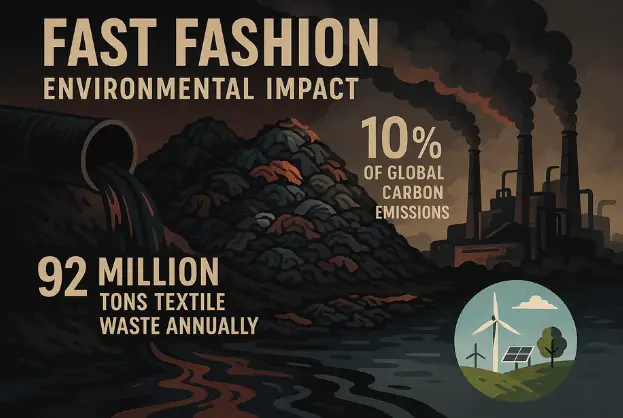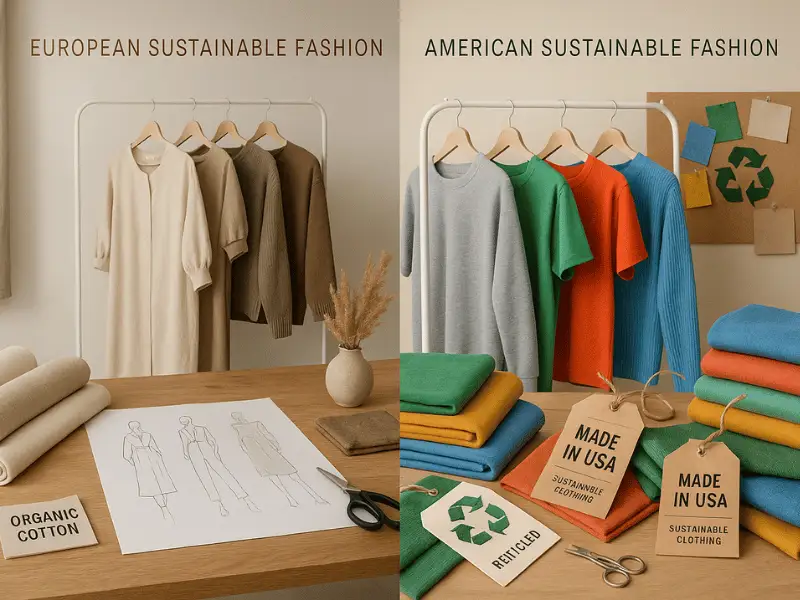
What Is Sustainable Fashion? How European Innovation and American Markets Are Revolutionizing Style
The fashion industry is transforming rapidly. European designers pioneer ecological fashion innovations while American consumers demand transparency, creating a powerful sustainable fashion movement across both continents. From Milan’s eco-conscious runways to New York’s sustainable boutiques, “what is sustainable fashion?” has become a mainstream question.
This transatlantic shift addresses a critical issue – the fashion industry produces 10% of global carbon emissions. As the effects of fast fashion on the environment become clearer, consumers from Paris to Portland are rethinking their shopping habits. This guide explores how European sustainability expertise and American market influence are reshaping the future of fashion.
Table of Contents
History of Sustainable Fashion
The history of sustainable fashion traces back to the 1960s when European environmental movements first questioned industrial practices. However, the modern sustainable fashion movement gained momentum in the 1990s following major factory disasters in developing countries.
Europe led early initiatives – Germany introduced eco-labels in the 1980s, while Scandinavian countries pioneered organic cotton farming. The United States followed in the 2000s, with California brands like Patagonia setting environmental standards. The 2013 Rana Plaza collapse in Bangladesh became a turning point, accelerating both European policy reforms and American corporate responsibility programs.
Today, this movement spans from European Union’s circular economy action plan to America’s sustainable fashion initiatives, creating a global shift toward responsible production.
Why is Sustainable Fashion Important
The answer lies in fashion’s massive environmental and social impact. The industry consumes 93 billion cubic meters of water annually – enough to meet the needs of five million people. European studies show textile production generates more carbon emissions than international flights and maritime shipping combined.
From a social perspective, over 75 million people work in garment manufacturing worldwide, with many earning below living wages. European brands increasingly focus on fair labor practices, while American companies face growing pressure from conscious consumers demanding transparency.
The economic case is equally compelling. McKinsey research indicates that sustainable practices can reduce costs by 20-30% through efficient resource use. Both European regulations and American market demands are making sustainability not just ethical, but essential for business survival.
Effects of Fast Fashion on the Environment
The effects of fast fashion on the environment are devastating and far-reaching. Fast fashion produces 92 million tons of textile waste annually, with Americans discarding 81 pounds of clothing per person each year. European environmental agencies report that clothing production has doubled since 2000, while garment use has decreased by 36%.
Water pollution represents another critical concern. Textile dyeing is the second-largest polluter of water globally, with European rivers showing chemical contamination from fashion production. In the United States, microplastics from synthetic clothing washing cycles contribute to 35% of oceanic microplastic pollution.
The carbon footprint is equally alarming. Fashion accounts for 8-10% of global greenhouse gas emissions – more than aviation and shipping combined. European fast fashion brands produce 150 billion garments annually, most ending up in landfills within two years, where synthetic materials can take 200+ years to decompose.
Sustainable Fashion Examples
Sustainable fashion examples showcase how European innovation meets American market adoption. European pioneers like Stella McCartney (UK) lead with cruelty-free luxury, while Eileen Fisher (USA) champions circular design. Swedish brand Ganni uses organic materials, paralleled by American company Reformation’s eco-friendly production.
In Europe, Gabriela Hearst creates zero-waste collections, while Patagonia (California) sets environmental activism standards. Danish brand GANNI promotes rental culture, similar to American platform Rent the Runway’s circular model. These brands demonstrate sustainable practices from organic cotton sourcing to carbon-neutral shipping.
Mass market adoption shows promising trends. European retailers like H&M’s Conscious Collection and Zara’s Join Life line compete with American giants Target’s Goodfellow & Co. and Gap’s organic cotton initiatives. This transatlantic competition drives innovation while making sustainable style accessible to mainstream consumers across both continents.
Sustainability in Clothing Industry: Europe vs USA
Sustainability in clothing industry approaches differ significantly between Europe and America. European Union leads with regulatory frameworks – the EU Strategy for Sustainable and Circular Textiles mandates extended producer responsibility by 2025. France requires fashion brands to display environmental impact scores, while Germany implements strict textile recycling quotas.
The United States takes a market-driven approach. California’s Garment Worker Protection Act sets labor standards, while New York considers the Fashion Sustainability and Social Accountability Act. American brands rely more on voluntary certifications like GOTS (Global Organic Textile Standard) and B-Corp status rather than mandatory regulations.
Investment patterns also vary. European governments fund circular economy initiatives – Netherlands invested €3 billion in textile innovation, while Nordic countries support bio-based fiber research. American investment comes primarily from private sectors, with venture capital funding sustainable fashion startups at $1.2 billion in 2023, demonstrating different but complementary approaches to industry transformation.

How to Become a Sustainable Fashionista
Becoming a sustainable fashionista starts with mindful shopping habits. European consumers lead by example – buying fewer, higher-quality pieces and embracing minimalist wardrobes. American fashion enthusiasts increasingly adopt this approach, focusing on timeless styles over trending items.
Key strategies for sustainable fashionistas:
Shop Secondhand First – European platforms like Vinted and Vestiaire Collective offer curated pre-owned luxury, while American sites like ThredUp and Poshmark provide accessible options. This reduces demand for new production while discovering unique pieces.
Choose Quality Brands – Support European innovators like Stella McCartney, Ganni, and Arket, or American pioneers like Reformation, Everlane, and Patagonia. These brands prioritize transparent supply chains and ethical manufacturing.
Practice Slow Fashion – Buy versatile pieces that work across seasons. European fashion weeks increasingly showcase timeless designs, while American brands focus on capsule collections that maximize outfit combinations.
Care Properly – European laundry traditions emphasize cold washing and air drying, reducing energy use by 60%. Proper garment care extends clothing life significantly, making each purchase more sustainable.
Embrace Rental Culture – For special occasions, use European services like HURR or American platforms like Rent the Runway. This maximizes garment utilization while minimizing environmental impact per wear.
Conclusion
The sustainable fashion revolution bridges European innovation with American market power, creating unprecedented opportunities for positive change. From Scandinavian circular economy policies to California’s environmental activism, both continents demonstrate that sustainable in fashion isn’t just possible—it’s essential for the industry’s future.
As European designers pioneer ecological fashion technologies and American consumers drive demand for transparency, the transformation accelerates. Whether you’re inspired by European minimalism or American innovation, becoming part of this movement starts with simple choices: support transparent brands, embrace secondhand shopping, and prioritize quality over quantity.
The future of fashion lies in this transatlantic collaboration—where European sustainability expertise meets American scaling power, creating a more responsible industry for generations to come.
- What Does Emo Look Like? The Complete 2025 Fashion Guide
- What Is Sustainable Fashion? How European Innovation and American Markets Are Revolutionizing Style
- What Is Harajuku Fashion? A Journey Through Color & Culture
- Why Slow Fashion Matters and How You Can Embrace It
- Rave Wonderland’s Best-Selling Outfits and Why They’reWorth the Hype





